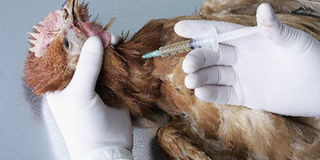Here is how we conquered cold weather diseases

Vaccinating poultry. FILE PHOTO | NATION MEDIA GROUP
What you need to know:
- When I enquired further, he told me he had noticed the hens were eating less and looked dull. It was also the beginning of the cold season.
- NCD is prevalent during hot, dry and windy seasons when conditions are conducive for airborne transmission. The NCD diarrhea also has a characteristic tinge of green.
- During cold seasons, birds tend to increase their feed intake to generate heat required to keep their bodies warm.
Every day, before I go to bed, there is some information my manager texts me always: Number of eggs laid. I then divide the number of eggs by the number of hens to get the rate of laying.
This number has always ranged between 50 and 70 per cent. At one point the number hit 80 per cent for one batch of hens, but for one week only.
On this particular week (June 23), I was counting my losses. For a whole week, the rate was between 20 and 30 per cent. At first I suspected counting error or theft by the worker.
But having engaged Cleophas for almost eight months, the one thing I can vouch is his honesty and work ethic. Another possibility was hens eating their eggs, a form of cannibalism that I have experienced twice in the past. As you may recall, I tackled it by giving the birds extra calcium in form of lime and bone meal. It is also easy to observe this phenomenon.
HENS LOOKING DULL
Now, why were my eggs not adding up? When I enquired further, he told me he had noticed the hens were eating less and looked dull. It was also the beginning of the cold season.
I didn’t waste time to call the vet, Omari, to see if there was an illness creeping in. I always make a point to consult the experts because they can diagnose problems faster than me.
When I spoke to him over the phone, he was categorical that we were dealing with Chronic respiratory Diseases (CRD). “Oh, no. Not again,! I exclaimed.
He noticed mucous from the nostrils, whitish diarrhoea, ruffled feathers, wasting, refusal to feed and cuddling. He also noticed spots on the eye lids and sleepiness.
From the symptoms, I had assumed we were dealing with New Castle Disease but he was categorical on this one: “NCD is prevalent during hot, dry and windy seasons when conditions are conducive for airborne transmission. The NCD diarrhea also has a characteristic tinge of green.”
‘Approximately how many are infected?” I enquired.
‘About 20 per cent,” he said. I was a worried man.
ORAL ANTIBIOTIC
If you recall, sometime last year in November, I had a similar problem and my vet diagnosed CRD. At that time, I lost about 41 birds and he prescribed an oral antibiotic called Tylosin. CRD, he explained is caused by a bacteria called Mycoplasma Avium and is different from Avian Influenza which is caused by a virus.
This time, instead of prescribing the oral antibiotic, he opted for the injection. “The injection, unlike the oral powder, has a higher cure rate of about 80 per cent,’ he explained. I paid Sh2,500 for the injection in addition to Sh900 for Amilyte and Livergen, two multivitamins that I was required to give the birds in water before giving the injections.
INCREASED HATCH RATE
Now, I am a happy man. A month later, the hatch rate has increased to 50 per cent and my aim is to reach at least 70 per cent.
The agronomists I have spoken to say that productivity in animals is dependent on genetics, food conversion efficiency, disease control and quality of feeds.
In my case, it is clear that the infection in my flock affected egg production, but I can’t also rule out weather conditions. During cold seasons, birds tend to increase their feed intake to generate heat required to keep their bodies warm. They also tend to drink less water and huddle together to keep warm.
This means to maintain their energy requirements, I need to give more feeds. However, this automatically increases my costs. To avoid this, one expert advised me to increase the amount of oily and fatty feeds in the diet. The reason she gave was that for every gram of fat, the body generates nine calories of energy.
A gram of carbs or protein, on the other hand, generates four calories only. This means that one gets more calories from every gram of fatty foods compared to carbs and proteins.
PREVELENT DISEASES DURING COLD AND RAINY SEASONS
I was also informed that some diseases like gumboro, fowl pox, fowl cholera, E. coli and salmonella are more prevalent during cold and rainy seasons. Luckily, for me, my birds are vaccinated against these diseases.
I have now developed a Dos and Don’ts for managing cold weather diseases and I can say I am on top of my game. First, I use raw materials like high fat soya instead of low fat. I also ensure that the wood chippings are changed every one week instead of the usual two weeks to keep the floor dry and clean most of the time.
“Dump litter resulting from wet floors is a sure recipe for growth of fungus and bacteria like salmonella,” one expert intimated to me. I also change the water more regularly and make sure to de-worm every three months. So far, I have only lost five birds in




